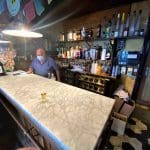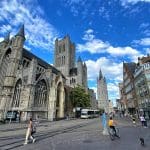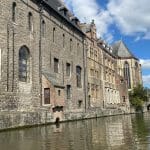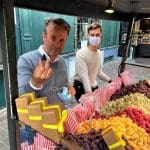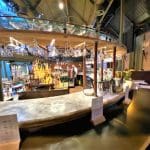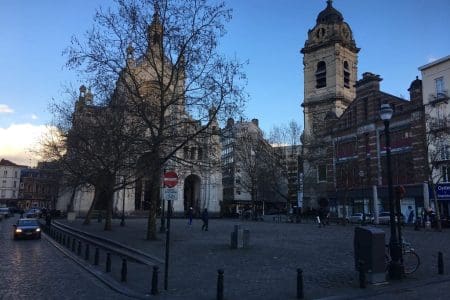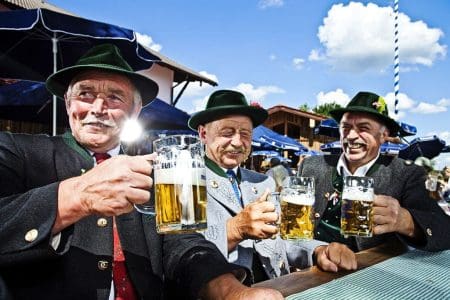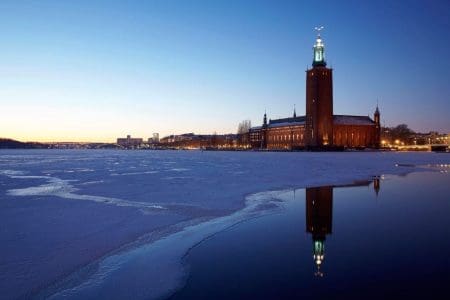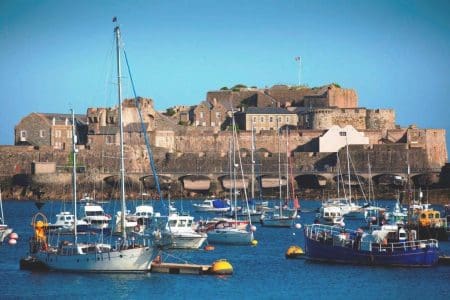Mark Bibby Jackson travels to Belgium to discover the myriad of things to do in Ghent, a city with a rebellious heart and the most amazing altarpiece.
One of the great experiences when travelling is to stumble unexpectedly upon a gem, albeit one not exactly hidden. Settling down for a beer across the road from Ghent’s Town Hall I ask the barman how long they have been open. “Since 1238,” he replies. I soon discover that Café Den Turk is the oldest bar in the Belgium city. The beer has aged well.
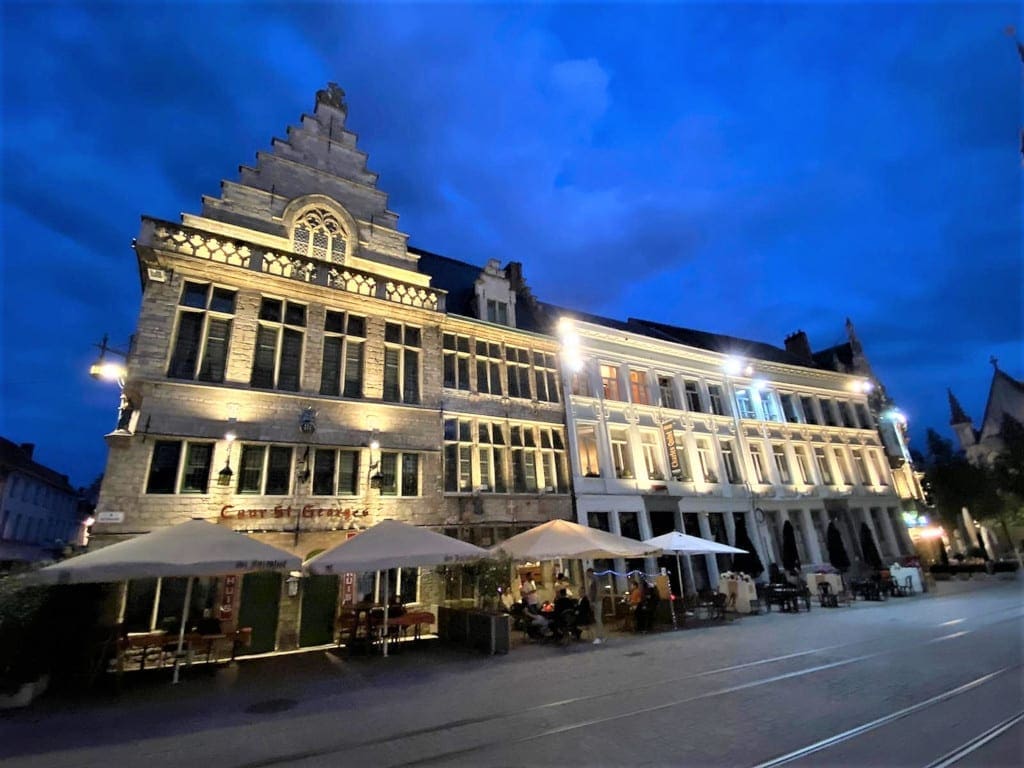
It is my first night in Ghent and I decided to pop in for a quick nightcap as the Turk is just across the road from my hotel. The light is quite amazing, bestowing an ethereal quality to the darkened blue skies that even my limited photography skills manage to capture.
Ghent Town Hall and De Stroppendrager
The following morning I find myself standing once more outside Café Den Turk only this time I am looking at the Ghent Town Hall on the other side of the street. I am about to embark on a food tour of Ghent spiced up with titbits on Flemish city’s rich history with my guide Bruno. It is he who points out the stark difference between the two sides of the building in front of me.
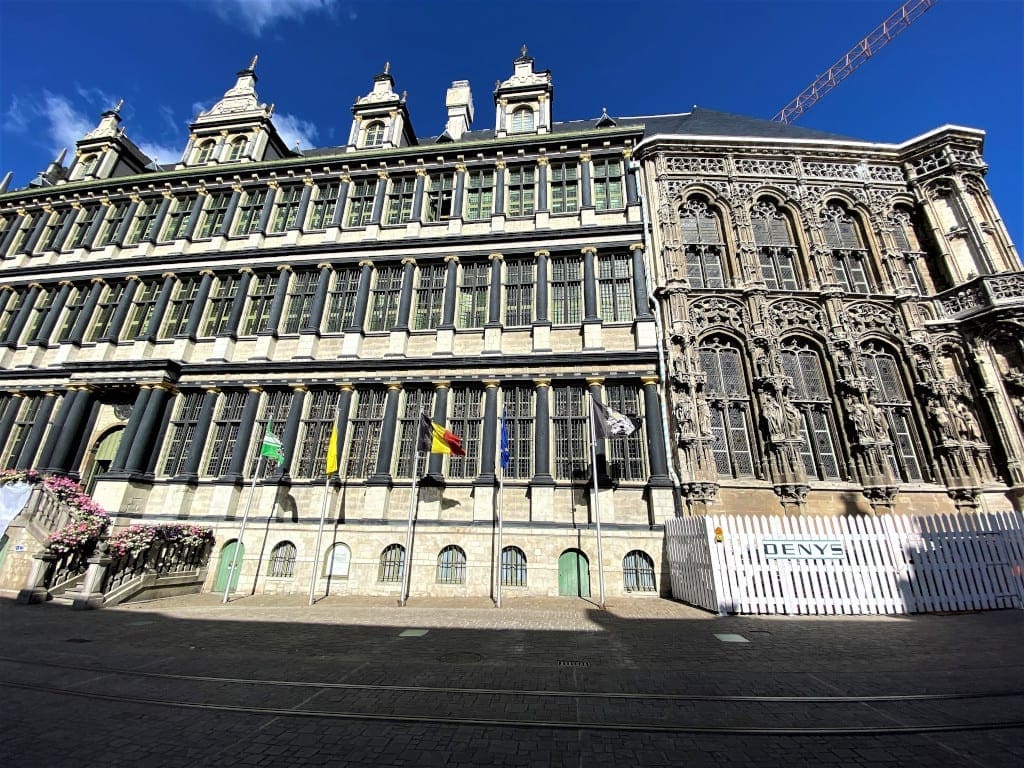
While the façade of the right side of the building is in the Late Gothic style of the early 16th Century, the left-hand represents the Renaissance style dating from 1559 to 1618. The former was preferred by Charles V (1500-1558), the Holy Roman Emperor, who was born in the city, the latter by the townsfolk who completed the building after his death.
At the time Ghent was one of the richest cities in Europe, its wealth largely owing to its location at the meeting of two rivers – the Lys and the Scheldt. The name Ghent is thought to derive from the Celtic word Ganda, meaning ‘confluence’. By 1300 the prospering city had some 50,000 inhabitants. The warehouses that still stand beside the old harbour in the heart of the city, were crammed full of grain collected as a tax imposed on the merchants who transported their goods along the waterways. A canal was even dug to the coast in order to ease access to the lucrative English market.
Charles V was not a popular son of the city, and the townsfolk of Ghent rebelled on numerous occasions against his iron rule. This culminated in 1840 when the Emperor forced many of the city’s dignitaries to kneel on the floor dressed in their shirts with a noose tied around their necks. Still, now the citizens of Ghent are called De Stroppendrager or The Noose Bearer, a nickname that reflects their proudly rebellious nature.
I suspect the deviation in design of the Town Hall was quite deliberate, as much reflecting the townsfolk hatred for Charles V as for the evolving architectural fashion.
Mammelokker and Ghent Belfry
The Town Hall is just a few paces from Ghent’s magnificent central Sint-Baafsplein Square which contains the Ghent Belfry, as well as St Bavo’s Cathedral and St Nicholas’ Church, the three great medieval towers of Ghent.
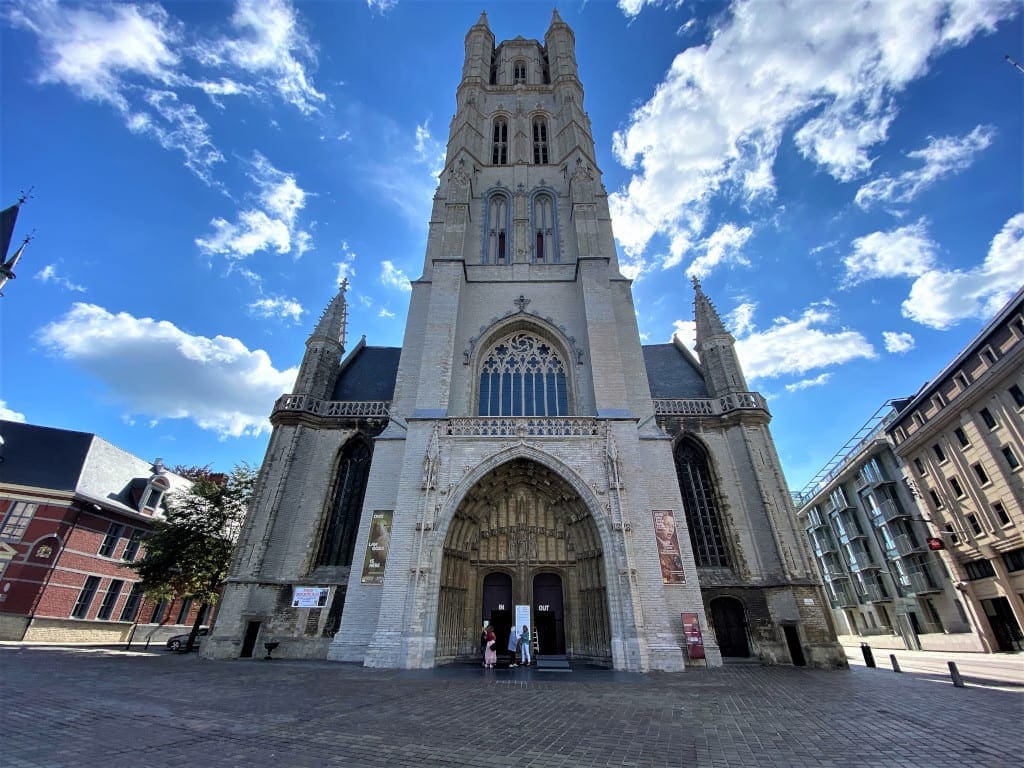
Built in the 14th Century, the 91-metre tall Ghent Belfry – the tallest in Belgium – is on Unesco’s World Heritage List. It served as a watchtower. Here merchants would keep their privileges. The Belfry also symbolised the importance of Ghent’s merchants, its tower challenging the authority of the Church and Crown who had their own monuments of power in Ghent Cathedral and Ghent Castle.
Next to the belfry is a small 18th century annex that served as the entrance to the city jail and is called the Mammelokker, in reference to Cimon, who, according to Roman legend, defeated death by having his own daughter breastfeed him during his incarceration. Clearly, the people of Ghent venerate rebels, even ones from Roman times. It comes as little surprise to discover that the Belgian Socialist party was founded here.
Old Harbour, Brothels and Ghent Castle
The heart of Ghent is wonderfully compact. A short walk takes me from the square to the old harbour.
This was the centre of the city’s wealth and prosperity during the middle ages, so perhaps it is appropriate that here many of the city’s restaurants and hotels have congregated. The oldest warehouse dates back to 1200, but perhaps the most interesting building in the harbour is that which currently houses the Marriott Hotel.

On its facade two swans stand back to back. The birds are traditionally associated with love. According to Bruno, in medieval times the building used to be a house of ill-repute where sailors would meet ladies of the night. How times have changed.
Close to the harbour, on the bank of the river Lys, is another of Ghent’s standout buildings. The Castle of the Counts was built for Count Phillip in 1180, although a wooden version pre-dated it. As the Count acted as the French King’s emissary in the city, his popularity with the rebellious townsfolk was in a constant state of flux. The strongly fortified Ghent Castle, built to protect the town from invading Vikings, provided him with safe haven when matters got out of control.
Here too the Count would torture disobedient townsfolk, so it is little surprise that Ghent Castle has been turned into a museum with its very own house of horrors torture chamber.
In 1949, the Castle was temporarily seized by the people on a topic close to the heart of most townsfolk – the price of beer. The occasion is commemorated each November, when the townsfolk once more take to the castle walls, beer in hand for a day.
Gruut Beer without the Hops
As throughout the country, beer is an essential part of life in Ghent. In 1900, the city had some 100 breweries, one per each 30 inhabitants though that number declined considerably due to the world wars.
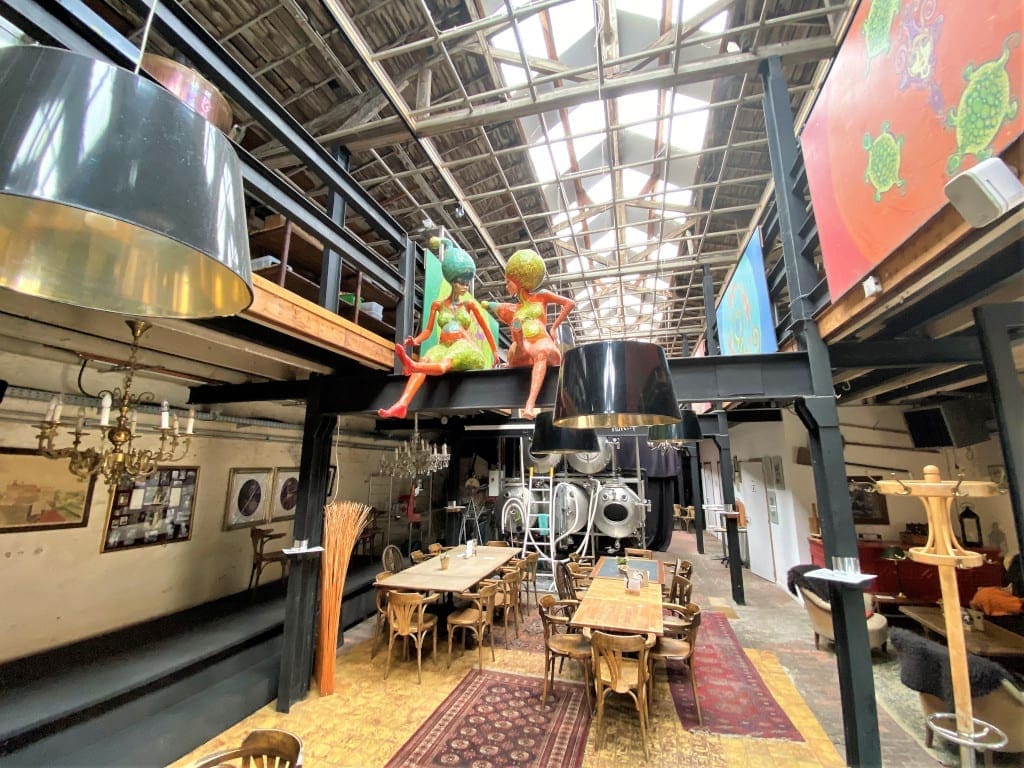
My city tour concludes at one of the newest breweries in the city, Gentse Gruut. Its founder, Annick de Splenter, comes from a family of brewers, her father Yvan is a member of the Desplenter brewery, sometimes known as the Riva Brewery, that was founded in 1896.
“At the weekend we always used to talk about brewing. As a girl I was fascinated by the whole process of brewing,” Annick explains the origins of her love affair with beer while pouring me a glass. She established her own brewery in 2009.
What distinguishes Gruut’s beer is the absence of hops. Annick has rediscovered the way beer was made before hops were introduced in the 13th century, through using a mixture of herbs. The only Gruut beer to have any hops is the trippel beer, appropriately called Inferno at a mere 9%.
“It’s difficult to eliminate the hops,” Annick explains. “I studied it for two years.”
The result is excellent. All the beers I tasted were clean and fresh without leaving any lingering hoppy aftertaste on the back of my throat. Annick assures that the lack of hops avoids you getting a hangover after drinking her beers, except perhaps the Inferno. It also means that the beer won’t last as long, so it is brewed in 20-litre barrels that only last a week.
The Ghent Altarpiece
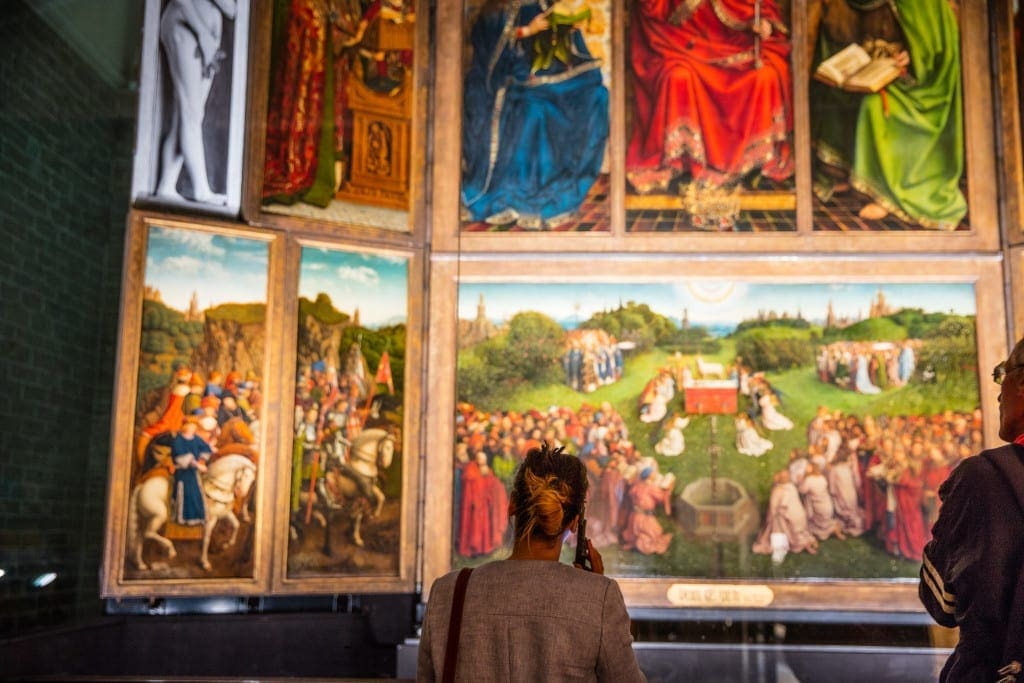
The highlight of any trip to the Belgian city has to be viewing the Ghent Altarpiece, or ‘The Adoration of the Mystic Lamb’. Completed by the Van Eyck brothers in 1432, this is one of the true masterpieces of medieval art. Its 18 panels depict various stories from the Bible, as well as portraits of Joos Vijd, the church warden who commissioned the work, and his wife.
The painting has somehow managed to survive fire and theft, famously being rescued from the Nazis in 1945 by the ‘The Monuments Men’. The George Clooney film about the rescue of the Ghent Altarpiece starts in St Bavo’s Cathedral.
Painstakingly restored from 2012, the Ghent Altarpiece has only recently been returned to St Bavo’s, where it is on display as part of the Van Eyck Year that has been extended into 2021 due to the disruptions caused by COVID-19. On 25 March 2021, it was moved to a new setting centre inside the cathedral to form part of the new Visitor Centre experience. The new arrangement improves the visitor experience as well as protecting the masterpiece from age and theft.
Even if, like me, you are an unbeliever, it is impossible not to be impressed by the quite incredible colours and the use of perspective that was ground-breaking at the time. Its beauty alone justifies a trip to Ghent, although the city has so much more to merit repeat visits. And I for one am perfectly happy to comply.
Things to Do in Ghent Photo Album
Van Eyck Year
Events for the Van Eyck Year, include Lights on Van Eyck, a combination of multimedia art, music and video mapping by British artist, Mat Collishaw in St. Nicholas’ Church, until the end of September 2021. There is also a Seven Senses Tour, a three-hour sensory tour that takes you in the footsteps of Van Eyck through Ghent including food, street art and shopping options only open to the public on this occasion, including a half-hour boat ride.
If you have enjoyed Mark’s travel tales of things to do in Ghent, why not try his From Beer to Mussels : Things To Do in Brussels?
Ghent Hotels
Apart from the Marriott, Ghent has a wide range of hotels, I stayed at the NH Belfort, which was very comfortable and well located right next to the town hall, and just across from the Café Den Turk. The city has many options to suit any budget. To check out what is on offer, fill in the form below.
Train from Brussels to Ghent
The simplest, most comfortable and environmentally friendly way to travel from the UK to Ghent is to by Eurostar from London St Pancras to Brussels. Regular trains run from Brussels to Gent Sint Pieters Station, taking around 30 minutes. From there take the No. 1 tram to the city centre, or walk approximately 40 minutes.
Nibbling Tour of Ghent

Bruno from Vizit Gent took me on a half day ‘Sneukelen Met Stijl’ nibbling food tour of Ghent, which included visiting the Old Fish Market for some genever and nibbles, an artisanal chocolate shop as well as trying some of Ghent’s famous fruit flavoured noses. Details of the tour can be found here.
Ghent Restaurants
You will be spoilt for choice by the restaurants in Ghent. On the first night I dined al fresco on the terrace at Pakhuis, where I had a couple of Belgium classics – shrimp croquettes and moules frites, both washed down by excellent Belgian beer. My second evening was at Meme Gusta, a more contemporary restaurant where I discovered a new (for me) Belgian dish – poling in t groen – eel in a green herb sauce, which was quite excellent. My final lunch was at Du Progress, one of the many atmospheric terrace restaurants on the Korenmarkt.
Ghent Citycard
With so many things to do in Ghent it is a good idea to purchase the excellent Citycard that allows you access to museums, galleries and cathedrals across the city, including viewing the Ghent Altarpiece, as well as a river cruise, and use of the trams. Details of how you can purchase the CityCard Gent can be found here. Alternatively you can use Taxi Gent while in the city or to travel from the airport.
More information on Things to Do in Ghent
Visit the official Ghent tourism site at https://visit.gent.be/en for ideas on things to do in Ghent, and for Flanders as a whole, visit: www.visitflanders.com. Images of Ghent Altarpiece supplied by Visit Flanders, all others taken by Mark Bibby Jackson.
